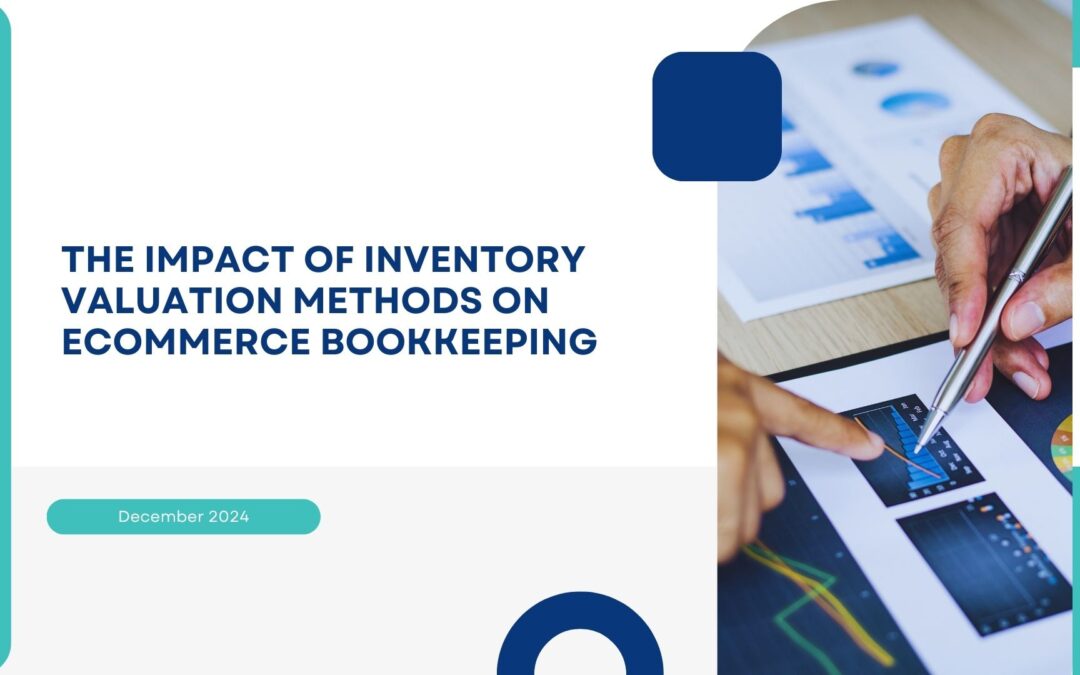The Impact of Inventory Valuation Methods on Ecommerce Bookkeeping
Inventory management is a cornerstone of every ecommerce Bookkeeping, directly influencing profitability and financial reporting.Selecting the appropriate inventory valuation technique is essential to efficient inventory management since it has a big influence on bookkeeping and overall company performance.
This article examines the most widely used techniques for inventory valuation, their effects on financial statements, and how they impact an e-commerce company’s bookkeeping. Businesses may maximize income, preserve accuracy, and comply with regulations by being aware of these techniques.
Why Inventory Valuation Matters in Ecommerce
Determining the cost of goods sold (COGS), ending inventory value, and gross profit all depend on inventory valuation. The choice of valuation method can influence financial results and compliance efforts for e-commerce enterprises, which frequently incorporate a variety of product categories and have a high inventory turnover rate.
The primary inventory valuation methods are:
- First In, First Out (FIFO)
- Last In, First Out (LIFO)
- Weighted Average Cost (WAC)
Each method has its pros, cons, and specific use cases, which we’ll explore in detail.
Common Inventory Valuation Methods and Their Impact on Bookkeeping
1. First In, First Out (FIFO)
Under FIFO, the oldest inventory items are sold first. This method assumes that products purchased first are the first to leave the inventory.
Impact on Bookkeeping:
- During inflation, FIFO shows higher profits because older, cheaper inventory is sold first, resulting in lower COGS.
- Ending inventory value is higher, reflecting the cost of newer stock.
- Financial statements may present a rosier picture, which can attract investors but may increase tax liabilities.
Best For: Ecommerce businesses with perishable goods or fast-moving inventory.
2. Last In, First Out (LIFO)
LIFO assumes the newest inventory items are sold first. This method is less common globally but is still used in some jurisdictions.
Impact on Bookkeeping:
- During inflation, LIFO increases COGS because newer, more expensive inventory is sold first, reducing taxable income.
- Ending inventory value is lower, which may underrepresent business assets.
- It may not align well with actual inventory flow, complicating audits.
Best For: Businesses aiming to reduce tax liabilities in markets where LIFO is permitted.
3. Weighted Average Cost (WAC)
WAC calculates an average cost per unit of inventory, distributing the total cost evenly.
Impact on Bookkeeping:
- COGS and ending inventory are stable and not influenced by price volatility.
- Simplifies calculations and reduces discrepancies during inventory audits.
- May not reflect the true cost dynamics if prices fluctuate significantly.
Best For: Ecommerce businesses with consistent pricing or those handling bulk items.
How Inventory Valuation Affects Financial Reporting
- Cost of Goods Sold (COGS): Different methods impact how much is deducted from revenue, influencing gross profit.
- Tax Obligations: Higher COGS (as in LIFO) can reduce taxable income, while lower COGS (as in FIFO) may lead to higher taxes.
- Inventory Management: Accurate valuation ensures businesses have a clear view of their assets and can plan reorders effectively.
- Investor Perception: Financial statements shaped by valuation methods can affect how investors and stakeholders view the business.
Choosing the right valuation method aligns with your ecommerce business goals and regulatory requirements.
Best Practices for Ecommerce Bookkeeping with Inventory Valuation
1. Align Valuation with Business Goals
Examine your company’s financial plan. For example, LIFO can be appropriate if reducing tax liability is a top concern. On the other hand, FIFO is effective in increasing reported profits.
2. Leverage Technology
Make use of sophisticated accounting and inventory management programs like NetSuite, Xero, or QuickBooks. By automating computations, these technologies guarantee bookkeeping correctness.
3. Stay Compliant with Regulations
Understand tax regulations and reporting requirements in your region. Some methods, like LIFO, are prohibited in specific jurisdictions.
4. Regularly Audit Inventory
Conduct periodic inventory counts to ensure records match physical stock. This minimizes discrepancies and prevents costly errors in financial reporting.
5. Consult Financial Experts
Work with experienced accountants or bookkeepers who specialize in ecommerce businesses. Their expertise ensures accurate application of inventory valuation methods.
Adapting to Global Ecommerce Challenges
For ecommerce businesses operating internationally, additional complexities arise:
- Multi-Currency Transactions: Exchange rate fluctuations can affect inventory valuation.
- Diverse Tax Regulations: Different countries have varying requirements for inventory reporting.
- Cross-Border Shipping Costs: Factoring these into inventory costs requires precision.
Advanced bookkeeping tools and expert guidance are essential to navigating these challenges effectively.
Conclusion
Methods of inventory valuation are essential to any e-commerce company’s bookkeeping. Whether using FIFO, LIFO, or WAC, the choice has a direct impact on operational effectiveness, compliance initiatives, and financial results. Ecommerce entrepreneurs can optimize their financial procedures and attain sustained prosperity by coordinating valuation techniques with business objectives, utilizing technology, and consulting professionals.
FAQs
1. What is the best inventory valuation method for an ecommerce business?
The best method depends on your business goals. FIFO suits businesses prioritizing accurate inventory representation, while LIFO may reduce tax liabilities. WAC is ideal for stability in pricing.
2. How does inventory valuation impact taxes?
Valuation methods affect COGS, influencing taxable income. For example, higher COGS in LIFO reduces taxes, while lower COGS in FIFO may increase them.
3. Can I change my inventory valuation method?
Yes, but it typically requires regulatory approval and proper documentation to ensure compliance with accounting standards.
4. How do I handle inventory valuation for international sales?
Use software that supports multi-currency transactions and consult experts to ensure compliance with international accounting standards.
5. Is automation necessary for inventory valuation?
Automation simplifies calculations, reduces errors, and ensures consistency, especially for businesses with high transaction volumes. It’s highly recommended for scalability and efficiency.
